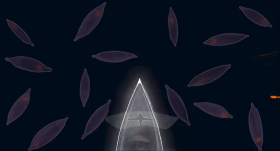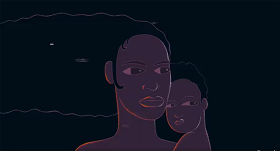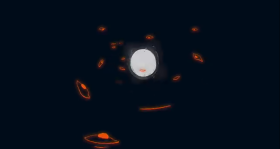Exploring perspectives through animation
Key inquiry question #1
Promotional animation/multimedia
Focus text/s
Eight Days in Kamay — promotional video for social media by Jake Duczynski
Watch the video on the State Library of NSW's Facebook page
Learning intention
Students are learning to:
- Analyse the use of visual techniques to represent cultural stories
- Investigate how different perspectives of history can be represented through visual texts
- Compose unique texts using an animation as stimulus
Success criteria
Students will be successful when they can:
- Explain the use of visual techniques in an animation and analyse their impact on viewers
- Discuss differing perspectives and point of view
- Write creatively in response to an animation
Student Activities
Animation Analysis
Students investigate alternative perspectives of the events, people and places in Australian history and how they are represented visually in art and animation.

Perspectives
Students investigate alternative perspectives of the events, people and places in Australian history and how they are represented visually in art and animation.

Create
Students use the animation as a stimulus for their own writing. First, students compose their own narration and or voiceover for the animation, before choosing a still frame from the animation to inspire the composition of a poem.

Background information for teachers and students
This short film was created by film maker Jake Duczynski to promote the State Library’s exhibition Eight Days in Kamay. The film appeared on the State Library’s social media channels on 5 August 2020, to inform viewers about the exhibition and encourage them to visit the Library to see the exhibition in person.
Jake Duscynski is a Gamilaraay and Mandandanji artist and animator. His work explores Aboriginal culture through animation and storytelling, and he is interested in how technology can assist in cultural collaborations, preserving culture and visualising worlds.
Background on the purpose of the film
The purpose of this animation is to promote the exhibition Eight Days in Kamay, but it also aims to do more than that. This film brings to the fore a perspective of an event from Australian history that hasn’t been represented before. The story of Cook and the Endeavour has often been one-sided, and this animation brings a much-needed perspective from the shore. The animation asks people to put aside their assumptions about what happened in 1770 at Kamay (Botany Bay), and open their minds to knowledge that has been silenced for many years. Because in history, it is important to hear from as many different perspectives as possible to form a stronger understanding of what happened.
Film analysis notes
General notes: The dark background of the animation suggests that this is occurring the night before the Endeavour’s arrival at Kamay (Botany Bay) and it builds a sense of anticipation, leaving viewers wondering what will happen next. The transcript reads: ‘In 1770, The Gweagal people of Kamay discovered James Cook and the Endeavour. This exhibition explores the eight days that followed. The use of the word ‘discovered’ is provocative here, because it is used to give agency to the Gweagal people who were equal participants in the events of 29 April 1770, but their voice has not often been heard before.
Still frame 1: This opening image shows a bird eye view of nawi (canoes used for fishing) on the waters of Kamay. The bays were full of nawi, each with a fire lit in the canoe — which can be clearly seen using this angle looking down into the canoes. These nawi with their small fires are a metaphor for the knowledge and ancient cultural practices. The nawi were immediately pulled ashore and carried over the sandhills after the Endeavour arrived in these waters. This reflects the disruption to the Gweagal people and to their knowledge and cultural practices caused by the arrival.
Still frame 2: This close-up of a woman and child invites the viewer to see this event as something that impacted real people and feel empathy for those that lived at Kamay (Botany Bay) at the time. In contrast to the ugly and dehumanising sketches that were produced by British people on the Endeavour, this is a beautiful image of a mother and child. The woman is still while her hair is blowing wildly, she is calm in the face of the strangers arriving in Botany Bay.
Still frame 3: The white circle is symbolic of an unknown, foreign entity that was sailing up the coast. There is a frame at the end of the film that flashes the Endeavour’s silhouette, but it’s mostly an unknown energy, completely unrecognisable. This was inspired by the words ‘warra warra wai’ which were spoken by the Gweagal people — meaning ‘you’re all dead’ spoken towards the Endeavour and those onboard. The elements circling the Endeavour/spirit entity are evolved versions of nawi, these are portrayed as abstracted eyeballs that observe this foreign entity – reflecting how many nations up the east coast watched the Endeavour’s progress for many days before it arrived in Kamay.
Still frame 4: A close-up of feet running, and the fast movement of people highlights the connection to Country, showing the bare feet impacting on the earth. It also increases the pace of the film, where the action is rising and you can see how quickly the people have become mobile. The oral history from Gweagal Elders also reveals how message sticks were sent up the coastline to tell of the arrival of strangers on the coast. These running feet could represent those messages making their way to their recipients.
Still frame 5: These flashes of colour are symbolic of fire. Signal fires were lit to alert tribes to the north that something different had arrived in the area. The flashes of colour move quickly, giving a sense of urgency, and the increasing pace builds anticipation and momentum. Long before any of the crew onboard the Endeavour saw any Indigenous people on the shore, they saw smoke from these fires. It was not clear what was going to happen or who the strangers were, but the Gweagal people knew that they were on their way. Fire can also be seen as a metaphor for knowledge, which is making its way up the coast.
Still frame 6: This final image portrays the Endeavour moving into the bay and pushing the nawi aside. It is a ghostly apparition displacing everything. This shot returns to a birds-eye view with the ghostly ship appearing transparent, in white — from the bottom of the screen into the centre. One by one the fires in the nawi go out, but the nawi remain. This symbolises the negative impact the arrival of the Endeavour had on the knowledge and culture of the Gweagal people — although they were silenced, their knowledge and culture were not entirely lost.
NSW Syllabus for the Australian Curriculum English K–10
A student:
EN4-RVL-01
- uses a range of personal, creative and critical strategies to read texts that are complex in their ideas and construction
Students will:
EN4-RVL-01
- Apply reading pathways to determine form, purpose and meaning
- Explore the main ideas and thematic concerns posed by a text for meaning
- Engage with the ways texts contain layers of meaning, or multiple meanings
- Explain how the use of language forms and features in texts might create multiple meanings
- Using a range of texts, describe how Aboriginal and Torres Strait Islander authors convey connections between Culture and identity
- Read a variety of texts that present a range of perspectives and experiences, including those of Aboriginal and Torres Strait Islander Peoples, and respond in a range of ways, including sustained written responses where appropriate
In each Year students must study examples of:
- visual texts
- media, multimedia and digital texts.
Across a stage of learning, the selection of texts must give students experience of:
- a widely defined Australian literature, including texts that give insights into Aboriginal experiences in Australia
- an appropriate range of digital texts, including film, media and multimedia.
- Aboriginal and Torres Strait Islander histories and cultures
- Critical and creative thinking
- Intercultural understanding
- Literacy
- Civics and Citizenship